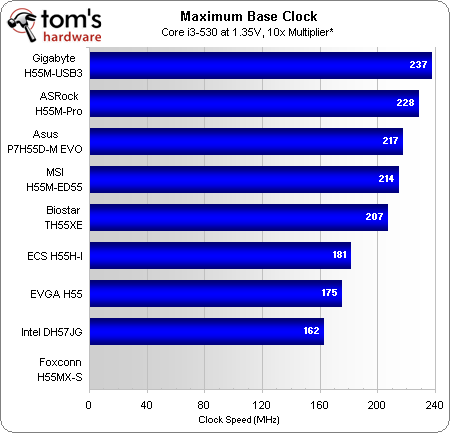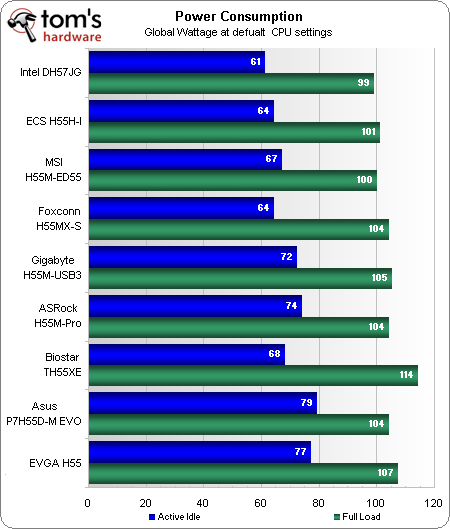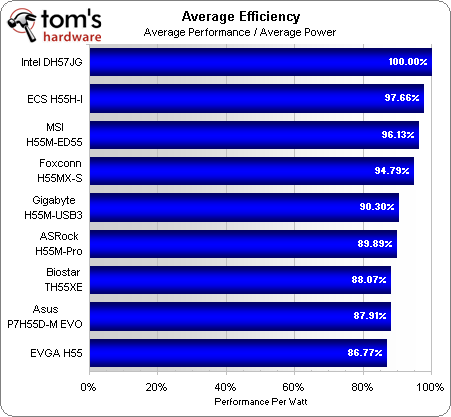Budget Computing: Nine H55 And H57 Motherboards Compared
Overclocking Results
| BIOS Frequency and Voltage settings (for overclocking) | |||
|---|---|---|---|
| Row 0 - Cell 0 | ASRock H55M-Pro | Asus P7H55D-M EVO | Biostar TH55XE |
| CPU Base Clock | 100-300 MHz (1 MHz) | 80-500 MHz (1 MHz) | 133-800 MHz (1 MHz) |
| CPU Multiplier | Yes | Yes | Yes |
| iGPU Clock | 133-1333 MHz (33) | 133-1500 MHz (33) | 133-2000 MHz (33) |
| DRAM Data Rates | BCLK x6 - x10* (x2) | BCLK x6 - x10* (x2) | BCLK x6 - x10* (x2) |
| PCIe Clock | 50-150 MHz | Not Adjustable | 100-150 MHz (1 MHz) |
| CPU Vcore | 0.84-1.60V (6.25mV) | 0.85-1.70V (6.25mV) | -0.08 to +0.20V (20mV) |
| GPU Core | 0.85-1.46V (12.5mV) | 0.5-1.75V (12.5mV) | +0.60V (20mV) |
| Uncore Voltage | 1.11-1.55V (62.5mV) | 1.10-1.90V (20mV) | 1.15-2.08V (15mV) |
| PCH Core | 1.05, 1.15, 1.25V | 1.05V, 2.00V (10mV) | 1.01-1.25V (50mV) |
| DRAM Voltage | 1.30-2.05V (50mV) | 1.20-2.20V (20mV) | 1.30-2.55V (15mV) |
| CAS Latency | 6-11 Cycles | 3-11 Cycles | 3-15 Cycles |
| tRCD | 3-15 Cycles | 3-15 Cycles | 3-15 Cycles |
| tRP | 3-15 Cycles | 3-15 Cycles | 3-15 Cycles |
| tRAS | 9-31 Cycles | 3-31 Cycles | 9-63 Cycles |
| BIOS Frequency and Voltage settings (for overclocking) | |||
|---|---|---|---|
| Row 0 - Cell 0 | ECS H55H-I | EVGA P55 FTW | Foxconn H55MX-S |
| CPU Base Clock | 133-600 MHz (1MHz) | 133-300 MHz (1 MHz) | Not Adjustable |
| CPU Multiplier | Yes** | Yes | Yes |
| iGPU Clock | Not Adjustable | Not Adjustable | Not Adjustable |
| DRAM Data Rates | BCLK x6 - x10* (x2) | BCLK x6 - x10* (x2) | BCLK x6 - x10* (x2) |
| PCIe Clock | 100-200 MHz (1 MHz) | 80-200 MHz (1 MHz) | Not Adjustable |
| CPU Vcore | +0.63V (10mV) | -0.4 to +0.63V (10mV) | Not Adjustable |
| GPU Core | Not Adjustable | +1.00V (25mV) | Not Adjustable |
| Uncore Voltage | +0.63V (10mV) | 1.05-2.00V (25mV) | Not Adjustable |
| PCH Core | Not Adjustable | 1.05-1.50V (25mV) | Not Adjustable |
| DRAM Voltage | +0.63V (10mV) | 1.20-2.13V (10mV) | +50 to 350mV (50mV) |
| CAS Latency | 3-15 Cycles | 3-15 Cycles | 3-15 Cycles |
| tRCD | 3-15 Cycles | 3-15 Cycles | 3-15 Cycles |
| tRP | 3-15 Cycles | 3-15 Cycles | 3-15 Cycles |
| tRAS | 9-63 Cycles | 9-63 Cycles | 9-63 Cycles |
| BIOS Frequency and Voltage settings (for overclocking) | |||
|---|---|---|---|
| Row 0 - Cell 0 | Gigabyte H55M-USB3 | Intel DH57JG | MSI H55M-ED55 |
| CPU Base Clock | 100-600 MHz (1 MHz) | 133-240 MHz (1 MHz) | 100-600 MHz (1 MHz) |
| CPU Multiplier | Yes | No | Yes |
| iGPU Clock | 400-2000 MHz (1) | Not Adjustable | 133-1333 MHz (33) |
| DRAM Data Rates | BCLK x6 - x10* (x2) | BCLK x6 - x10* (x2) | BCLK x6 - x10* (x2) |
| PCIe Clock | 90-150 MHz (1 MHz) | 100-110 MHz (1 MHz) | 90-190 MHz (1 MHz) |
| CPU Vcore | 0.50-1.90V (6.25mV) | Not Adjustable | +0.303V (6.1mV) |
| GPU Core | 0.20-1.68V (12.5mV) | Not Adjustable | Row 7 - Cell 3 |
| Uncore Voltage | 1.05-1.49V (20mV) | 1.10-1.25V (50mV) | 0.47-2.038V (5.3mV) |
| PCH Core | 0.95-1.50V (20mV) | Not Adjustable | 0.451-1.953V (5mV) |
| DRAM Voltage | 1.30-2.60V (20mV) | 1.20-1.70V (50mV) | 0.93-2.43V (15mV) |
| CAS Latency | 5-15 Cycles | 5-16 Cycles | 4-15 Cycles |
| tRCD | 1-15 Cycles | 5-16 Cycles | 3-15 Cycles |
| tRP | 1-15 Cycles | 5-16 Cycles | 3-15 Cycles |
| tRAS | 1-31 Cycles | 15-75 Cycles | 9-63 Cycles |
Of today’s motherboards, only the Foxconn H55MX-S completely lacked BIOS overclocking controls, while only Intel’s DH57JG completely lacked CPU multiplier control. That drops Foxconn from several charts, while limiting Intel’s base clock and memory frequency tests.
Our first Core i3-530 processor failed during a routine reboot at a mere 1.35V setting. Unable to determine whether the failure was the result of a voltage spike or an overly aggressive setting, we took the more cautious approach of retesting all boards at a 1.30V CPU core limit.
Biostar has put great effort into establishing a reputation as the best-value overclocking brand, and its results here are quite impressive. At a mere 1.30V limit, our low-cost dual-core reached nearly 4.4 GHz.
With no CPU core voltage adjustment, Intel’s mini-ITX motherboard topped out just short of 3.6 GHz.
Gigabyte’s base clock lead nearly shocked us, while EVGA’s deficit would be most easily explained by poor BIOS support for our Core i3-530 processor. With an unchangeable multiplier, Intel’s DH57JG uses the same base clock in this test as it had during our previous max CPU clock attempt.
Gigabyte’s support for higher base clocks extends to its higher DRAM bus clock, while EVGA’s base clock problem also translates to a DRAM overclocking issue, again most easily explained by a BIOS that’s not properly configured for our processor model.
Tiny motherboards with fewer components use less power.
Get Tom's Hardware's best news and in-depth reviews, straight to your inbox.
Low power and average performance give the smallest motherboards an efficiency lead and the largest model an efficiency deficit.
Current page: Overclocking Results
Prev Page Synthetic Benchmarks: SiSoftware Sandra Next Page Conclusion




